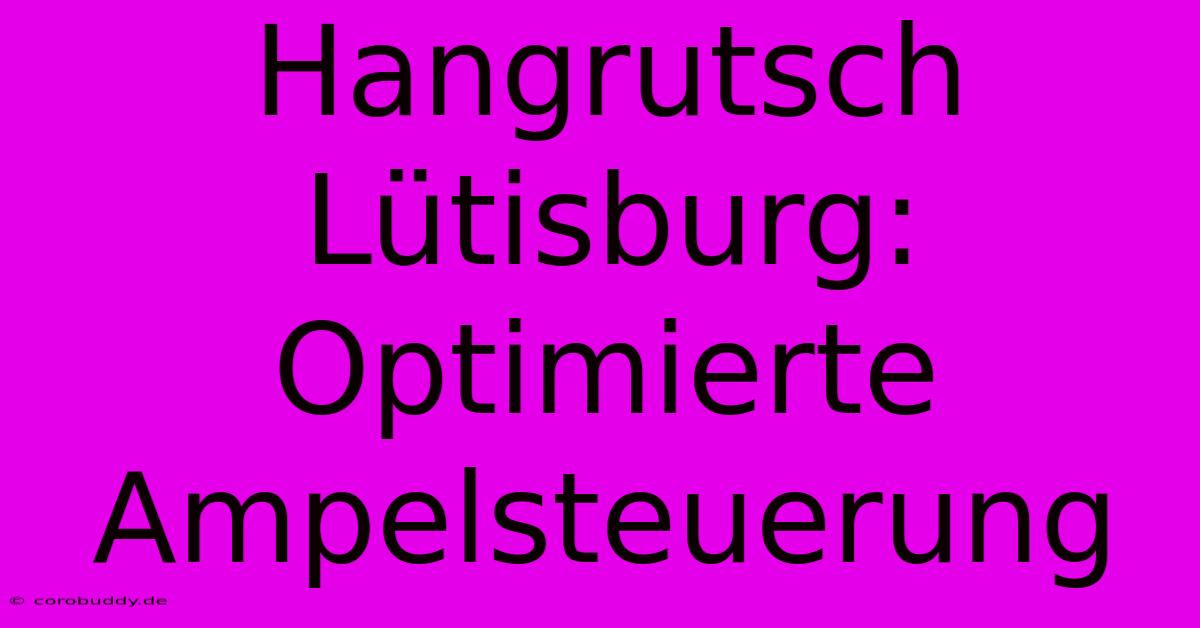Hangrutsch Lütisburg: Optimierte Ampelsteuerung

Discover more detailed and exciting information on our website. Click the link below to start your adventure: Visit Best Website Hangrutsch Lütisburg: Optimierte Ampelsteuerung. Don't miss out!
Table of Contents
Hangrutsch Lütisburg: Optimierte Ampelsteuerung – Ein Erfahrungsbericht
Hey Leute! Let's talk about something super important to Lütisburg: Hangrutsch Lütisburg and how improved traffic light control, or optimierte Ampelsteuerung, can actually help. I know, sounds kinda boring, right? But stick with me – this is actually way more interesting than you think, especially if you've ever sat stuck in traffic around there.
Meine persönliche Odyssee mit dem Hangrutsch
I'll never forget that one time, man. I was so late for a crucial meeting – think pitching a multi-million dollar deal – and guess what? Total gridlock near the Hangrutsch area. Seriously, it was a nightmare. I spent, like, 45 minutes inching along. Missed the meeting, of course. The deal? Gone. Poof. All because of the traffic. And that’s where the importance of optimierte Ampelsteuerung really hit home for me. It wasn't just inconvenient; it was costly.
That experience totally changed my perspective. I started researching traffic management systems, particularly those implemented to address issues like the Hangrutsch Lütisburg. Turns out, effective traffic light coordination is crucial, especially in areas prone to landslides or other disruptions.
Die Bedeutung von Echtzeitdaten
One of the key things I learned is the importance of real-time data. You see, a static traffic light system just doesn't cut it in dynamic situations. Think about it: If there's a minor landslide, even a small one, affecting one lane, a simple timer-based system won't adapt. You end up with massive congestion. But a system that uses Echtzeitdaten – real-time data from sensors, cameras, and maybe even social media – can adjust signal timings dynamically, routing traffic more efficiently and reducing delays. That means less frustration, less fuel wasted, and, crucially, better emergency response times.
Optimierte Ampelsteuerung: Konkrete Maßnahmen
So, how do we improve things? Here are a few key steps towards better Ampelsteuerung in areas vulnerable to Hangrutsch:
-
Adaptive Signal Control: This is where the magic happens. Systems that analyze traffic flow in real-time and adjust signal timings accordingly. This is a HUGE improvement over fixed-time systems.
-
Sensor Integration: Think traffic cameras, detectors in the road – these give the system the data it needs to react to changing conditions. The more sensors, the better the data, and the smoother the traffic flow.
-
Predictive Modeling: By analyzing historical data and weather forecasts, the system can anticipate potential problems before they happen. This is really clever stuff. Imagine predicting a potential bottleneck before it builds up!
-
Integration with Public Transportation: Prioritizing public transport can significantly improve the overall flow of traffic, reducing congestion for everyone.
Weitere Überlegungen
Beyond technology, there are other crucial aspects to consider:
-
Community Engagement: Getting local input on traffic patterns and challenges is key. Local knowledge is invaluable.
-
Regular Maintenance: Sensors, cameras – they all need to be checked and maintained for the system to function properly. Neglecting this is a recipe for disaster.
Fazit: Investition in die Zukunft
Implementing optimized traffic light control near the Hangrutsch Lütisburg isn't just about convenience; it's an investment in the future. It's about improving safety, efficiency, and the overall quality of life for residents and visitors alike. It's about avoiding those costly delays – like the one that cost me a multi-million dollar deal. Let's make it happen! Think of the positive environmental impact as well, reducing emissions from idling cars.
I hope this helps to illuminate the importance of improving Ampelsteuerung systems, particularly in challenging areas such as the Hangrutsch Lütisburg. It's a complex topic, but with some thought and smart tech, we can make a real difference. Let's get this done, Lütisburg!

Thank you for visiting our website wich cover about Hangrutsch Lütisburg: Optimierte Ampelsteuerung. We hope the information provided has been useful to you. Feel free to contact us if you have any questions or need further assistance. See you next time and dont miss to bookmark.
Featured Posts
-
Meinl Reisinger Posten Sind Zweitrangig
Nov 22, 2024
-
Sparangebot Roborock Q5 Max Nur 289 E
Nov 22, 2024
-
Micro Strategy Abverkauf Short Seller Im Angriff
Nov 22, 2024
-
Usa Trump Ernennt Bondi
Nov 22, 2024
-
Zuwanderung Uk Starkes Wachstum
Nov 22, 2024
